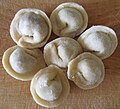Joshpara: Difference between revisions
CSV import Tags: mobile edit mobile web edit |
CSV import |
||
| Line 25: | Line 25: | ||
[[Category:Central Asian cuisine]] | [[Category:Central Asian cuisine]] | ||
{{food-stub}} | {{food-stub}} | ||
== Joshpara == | |||
<gallery> | |||
File:Düşbərə_yarımfabrikatı_1.jpg|Joshpara | |||
File:Chuchvara.jpg|Chuchvara | |||
File:Dushbara_Azerbaijani_cuisine.jpg|Dushbara Azerbaijani cuisine | |||
File:Shish_barak.jpg|Shish barak | |||
File:Пельмени_с_мясом_(неварёные).jpg|Pelmeni with meat (uncooked) | |||
File:Chuchvara4.jpg|Chuchvara | |||
File:Pelmeni_Russian.jpg|Pelmeni Russian | |||
File:Домашние_пельмени.jpg|Homemade pelmeni | |||
</gallery> | |||
Latest revision as of 11:18, 18 February 2025
Joshpara is a type of dumpling popular in the cuisine of several Central Asian and Middle Eastern countries. The name "Joshpara" is derived from two Persian words: "Josh," meaning boiling, and "para," meaning piece.
Origin and History[edit]
Joshpara has its roots in the culinary traditions of Persia, but it has spread to various regions, including Azerbaijan, Afghanistan, and Turkey. The dish is often associated with special occasions and is traditionally prepared in large quantities for celebrations and gatherings.
Preparation and Serving[edit]
The preparation of Joshpara involves a dough made from wheat flour, water, and sometimes eggs. This dough is rolled out and cut into small squares or circles, which are then filled with a mixture of minced meat, onions, and spices. The edges of the dough are folded to enclose the filling, creating a distinctive shape that is often compared to a boat or a crescent moon.
Once the dumplings are formed, they are boiled in a flavorful broth until they are cooked through. Joshpara is typically served hot, often in the broth in which it was cooked. It may be accompanied by various sauces or garnishes, such as yogurt, melted butter, or fresh herbs.
Variations[edit]
While the basic recipe for Joshpara remains the same, there are many regional variations. In Azerbaijan, for example, the dumplings are often smaller and more finely shaped, while in Afghanistan, they may be larger and more robust. The filling can also vary, with some versions using lamb, beef, or chicken, and others incorporating vegetables or cheese.
Cultural Significance[edit]
Joshpara is more than just a dish; it is a symbol of hospitality and celebration in many cultures. The process of making the dumplings is often a communal activity, with family members and friends gathering to prepare the dish together. This tradition reinforces social bonds and allows for the transmission of culinary skills from one generation to the next.
See Also[edit]
Joshpara[edit]
-
Joshpara
-
Chuchvara
-
Dushbara Azerbaijani cuisine
-
Shish barak
-
Pelmeni with meat (uncooked)
-
Chuchvara
-
Pelmeni Russian
-
Homemade pelmeni








